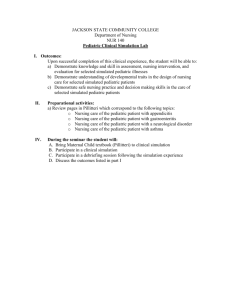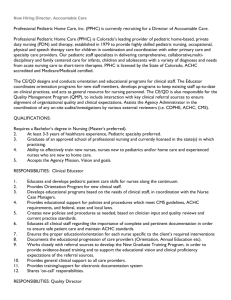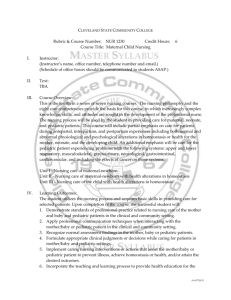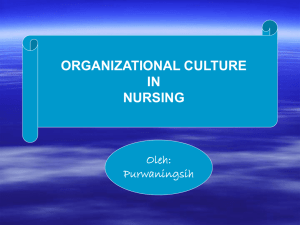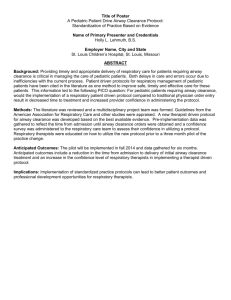PowerTemplate - Institute of Pediatric Nursing
advertisement
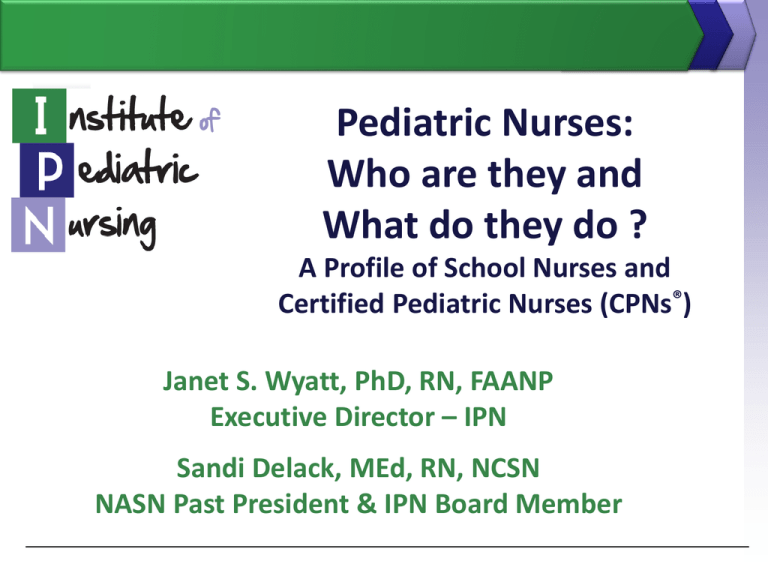
Pediatric Nurses: Who are they and What do they do ? A Profile of School Nurses and Certified Pediatric Nurses (CPNs®) Janet S. Wyatt, PhD, RN, FAANP Executive Director – IPN Sandi Delack, MEd, RN, NCSN NASN Past President & IPN Board Member Certified Pediatric Nurse (CPN ) Exam ® Launched 1989 Founding Leadership – Donna Wong, PhD, RN, CPN Total Certified Oct 2011 = 15,220 Definition of Pediatric Nursing • Includes health promotion, acute & chronic illness management and health restoration of infants, children, adolescents & their families. • Pediatric nurses practice in a variety of settings & roles such as direct caregiver, educator, consultant, advocate, or care coordinator. • Pediatric nurses assess, analyze, plan & implement nursing interventions & evaluate outcomes. Knowledge & Skills linked to pediatric nursing practice?? • Practice Analysis - Largest research survey ever completed of practicing pediatric nurses – over 2800 respondents • Respondents identified a total of 72 pediatric nursing knowledge competencies and tasks critical to pediatric nursing practice • These competencies and tasks are reflected in the exam PNCB’s 2008 Practice Analysis Study Total CPNs = 15,220 89% CPNs by Highest Degree (n= 15,220) 66% 25% 9% Dedicated , Experienced - CPN®s Certified an average of 6 yrs (range 0-30 yrs) With current employer = 13 yrs (range 0-49 yrs) 93% Plan to remain with current employer for next six months Examples of Competencies/Tasks on the CPN Exam Assessment • • • • Assess physical status, growth and development Assess nutritional status of child Assess barriers to care Assess & report signs of abuse and neglect Health Promotion • Teach health promotion strategies to child/family e.g. safety, infection control • Discuss environmental factors that influence health Examples (cont.) Management • Monitor for patient responses and adverse reaction to medication • Manage pain • Identify and intervene when patient needs immediate care • Nursing procedures (e.g. physiological monitoring, F&E admin., med. admin.) Top Five Illness Conditions Respiratory Gastrointestinal Infectious Disease Neurology Emergency Trauma CPN Exam Content Outline (cont.) Professional Role Incorporate evidence-based findings into practice Participate in disaster preparedness Recognize legal applications in clinical situations (e.g. assent) 2008 CPN ® Content Outline (150 questions) Assessment (30% ) Physical – Growth and development Psychosocial/Family Health Promotion (10%) Management (50%) Illness Psychosocial/Behavioral Chronic Care/End of Life Professional Role (10%) 2008 Pediatric Nursing Scope and Standards Pediatric Nursing Scope and Standards of Practice. A collaborative document combining pediatric nursing Scope & Practice documents from the ANA, SPN and NAPNAP Six Standards of Pediatric Nursing Practice ◊ Assessment ◊ Planning ◊ Diagnosis ◊ Implementation ◊ Outcomes Identification ◊ Evaluation 2008 Pediatric Nursing Scope and Standards 11 Standards of Professional Performance ◊ quality of practice ◊ education ◊ collegiality ◊ collaboration ◊ professional accountability ◊ ethics ◊ resource utilization ◊ leadership ◊ research ◊ advocacy ◊ professional practice evaluation 2008 – Published by ANA, NAPNAP and SPN “School nursing is a specialized practice of professional nursing that advances the well being, academic success, and life-long achievement of students. To that end, school nurses facilitate positive student responses to normal development; promote health and safety; intervene with actual and potential health problems; provide case management services; and actively collaborate with others to build student and family capacity for adaptation, self management, self advocacy, and learning.” NASN Membership Survey Results (~15,000) 92% Caucasian 29% Nationally Certified (NCSN) 14% > 36 years experience 86% public schools Education 50% Bachelors 28% Masters 10% Associate *3% are NPs • Most work directly for public schools • All work within public health. NASN 2007 Membership Survey National ratio of RN to students = 1:1151 National Board for Certification of School Nurses 27% HEALTH APPRAISAL 28% HEALTH PROBLEMS AND NURSING MANAGEMENT 20% HEALTH PROMOTION/DISEASE PREVENTION 10% SPECIAL HEALTH ISSUES 15% PROFESSIONAL ISSUES 250 test questions Does your district/school use electronic student health records? 56% use electronic health records (2009 NASN Survey) Potential New Knowledge/ Practice Competency Emerging Issues Affecting School Nursing Practice More school children are uninsured, underinsured and undocumented – public health departments depend on school health services for these children Increasingly complex care is provided in schools to medically fragile children and children with chronic health issues - schools hiring RNs to serve specific (special needs) students due to regulatory requirements Physical and psycho-social health status of children is confounded by new social and environmental threats Fragmented & underfunded school health resources Knowledge Expectations in Pediatric Nursing Practice CPN Assessment (30% ) • • Physical Assessment Psychosocial and G & D Health Promotion (10%) Management (50%) • Illness • Psychosocial/Behavioral • Chronic Care/End of Life Professional Role (10%) NCSN 27% HEALTH APPRAISAL 28% HEALTH PROBLEMS AND NURSING MANAGEMENT 20% HEALTH PROMOTION/DISEASE PREVENTION 10% SPECIAL HEALTH ISSUES 15% PROFESSIONAL ISSUES Is this content in Undergrad BSN/RN Education ? Are We Preparing Nurses For These Important Roles? Thank You! QUESTIONS?
